
Above - Byron Kaverman, 2015 GPI Player of the Year and one of the worlds best tournament poker players
Playing poker tournaments either semi-professionally or professionally can be quite challenging because of the variance and it often requires your full commitment. That’s why you need the best poker tournament training toolsout there, tools like ICMIZER.
Indeed, ICMIZER can help you improve your tournament play and most importantly, can tell you that at the end of the day, you made the right decision shoving your stack or calling an all-in, no matter the short-term results. Because, more often than not, that’s what tournament players need in the midst of a major downswing: an assurance that their play was actually +EV and +ICM EV and that they simply couldn’t do more.
Maybe you’re in the same position, maybe you’ve seen quite a lot of poker training videos but still aren’t quite sure about specific spots you ran into while grinding the tournaments. And maybe you aren’t that willing to spend your money on a real coach. That’s perfectly fine especially if you play the lower stakes and luckily for you, ICMIZER can be a great, affordable alternative IF you use it properly.
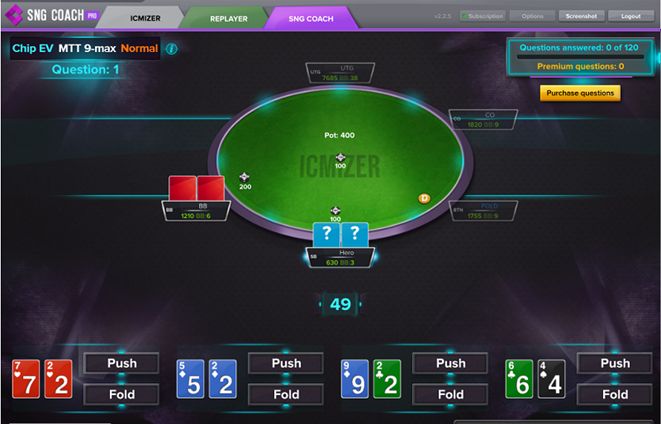
SNG Coach
And how about starting the guide with a piece of advice that could have effects on your play immediately: before starting your poker session, be sure to warm up and do some ICM quizzes.
With the development of ICMIZER 2, a very handy tool was introduced to the public: the SNG Coach. That’s where all the ICM quizzes are. If you buy at least the pro edition, you will have the opportunity to test your shove/call skills in the SNG Coach tab. Here, you can answer up to 120 specific ICM situations that have to do with pushing and calling ranges. Note that for every situation, the SNG Coach gives you four possible hands to choose from. For example look at the situation below:
So given a regular speed, non-final table, 9-man MTT, do you shove any two from SBwith three big blinds left? Or do fold the very bottom of your range? With every hand, you can choose either push or fold and then submit your answers. Whether your answers are good or not, you will have the opportunity to review the ranges just by clicking ICMIZE. There you will see the optimal ranges to shove/call in the given situation.
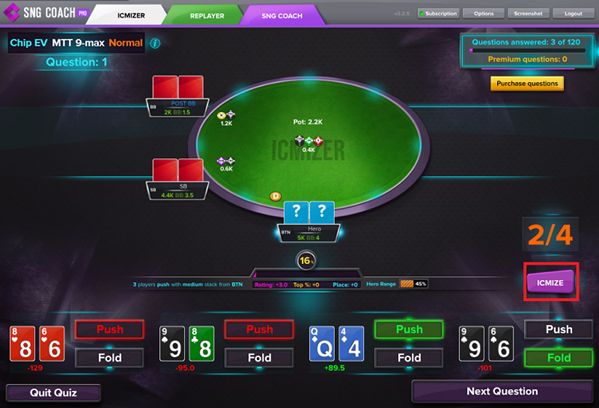
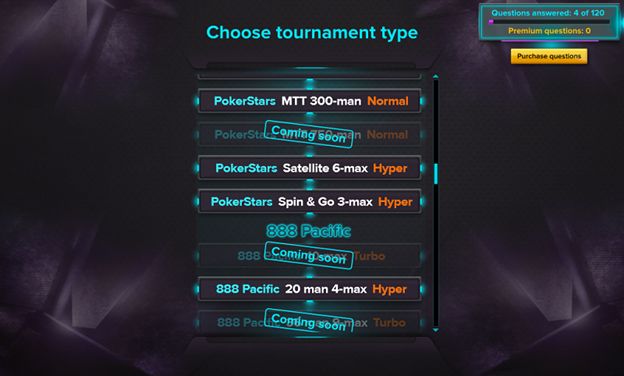
You can also choose specific quizz spots like pushing situations only or short stack (2-5 BB) spots only with four players left in a standard 9-man SNG.

By doing the quizzes before every poker session, your play will only get better.
ICMIZER Session Review
Now that we talked what to do just before the start of the session, let’s also talk about what you can do with ICMIZER after your usual grinding session.
Like a real coach, you can give ICMIZER some marked hands and ask him for advice. Yes, that means you can actually do some quite useful session reviews. The only downside is that the software can’t actually explain its thought process, it can only give you cold ranges and numbers. But given the amount of the useful information the tool can give you, we’re pretty sure that won’t be a problem for you.
Most of the post-session time will be spent pasting hand histories, loading hands and playing with ranges. This is where you’ll have the opportunity to analyze real-life poker hands. Sure, doing quizzes can be a lot of fun but the ranges you’ll see in the SNG coach will be based on Nash Equilibrium. And we all know your tournament opponents aren’t that good to play the game optimally. So you need to make adjustments and this is where a session review comes in.
Chip EV vs. ICM EV: What To Choose And When?
Just above the paste hand history button, you will have a selectable field that lets you choose the tournament format and most importantly, the EV type.
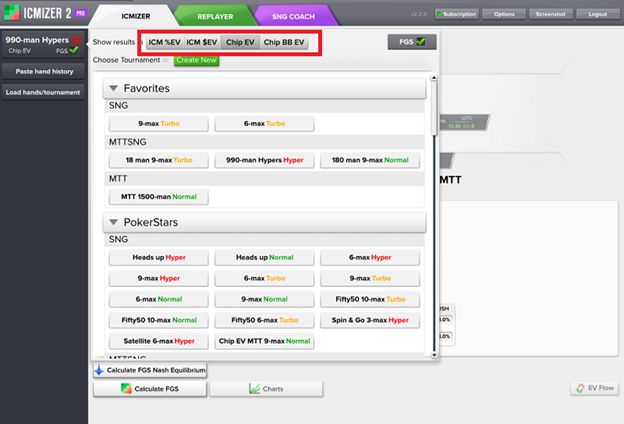
Choosing what EV to use is essential for ICMIZER to give you the right advice. Why? Well, let’s just explain with an example: let’s say you want to paste a 180-man MTTSNG hand played well before the money bubble and you choose the ICM EV. Unfortunately, the range ICMIZER calculates for you is plain wrong. In this situation, ICMIZER calculates the range as if you had reached the final table. For the software, the table it loaded is actually a final table with notable pay jumps. To set things right (at least partially), you have to select the Chip EV option.
While Chip EV may not be the optimal choice (as it considers the tourney basically a cash game), it is far closer to the truth than the ICM EV. ICM EV is only useful when you are at the final table.You can also expand and click on the MTT option but do not get ahead of yourself: yes, you can use the ICM EV with 18 players left and even with 60 but beyond that, the calculations are so complex that the ICM EV is off limit.

Tournament Type
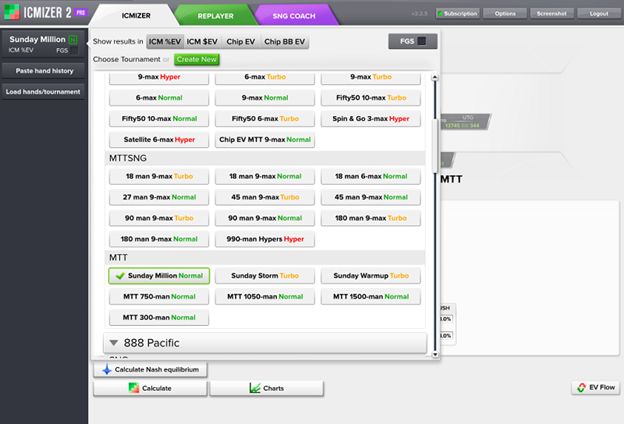
Besides the EV types, you can also choose the tournament type and luckily ICMIZER has a lot of options: from the PokerStars SNGs, MTTSNGs, MTTs and yes even the Sunday Million to 888, iPoker, party, Bovada, Winamax, OnGame and WPN SNGs.

FGS And Nash Equilibrium
The other two options to take into consideration whenever analyzing a poker tournament hand are the FGS and the Nash Equilibrium ranges.
FGS or Future Game Simulations is a very interesting concept that tries to solve some ICM limitations. FGS basically makes some assumptions over the future using the information available - size of the blinds and hero position - and use them to calculate the ranges more accurately. The downside is this: FGS uses Nash Equilibrium when ‘predicting’ the future and you cannot change that. So if you play the low stakes where few know about Nash, it’s probably better not to use FGS and only concentrate on the ICM and Chip EV.
Analyzing Poker Hands With ICMIZER
Keeping all the above in mind, you’re almost ready to use ICMIZER at its full potential. All you have to do now is copy your tournament hand history and start analyzing your play. Remember to adjust your opponents’ ranges before calculating your pushing/calling range. Read your notes, remember your reads (that’s why it’s important to try and review your play just after the grinding session) and assign villain a proper range; more often than not, the Nash ranges won’t be that accurate especially at lower stakes.
Also every time you hit the calculate button, make sure to look at the charts and visualize your whole pushing/calling ranges. You may have made the right decision with your particular strong hand but how wide is your pushing/calling range? Would you have considered pushing with eight-four suited? How about calling King-five off?
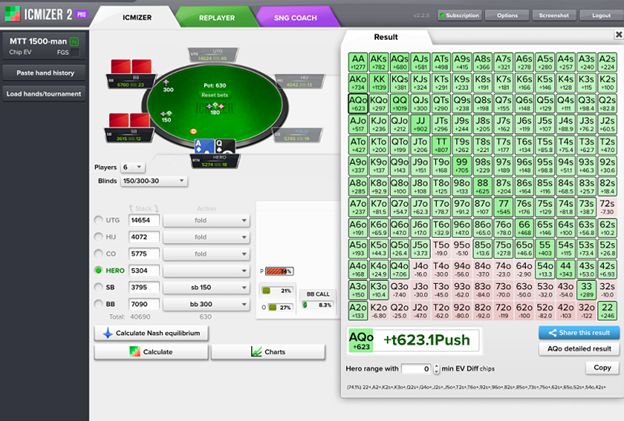
Good luck at the tables.
 More Top Rated Content
More Top Rated Content
Articles
- How to Make a Poker Schedule - Tools You Can Use
- Motivational YouTube Videos - Friend or Foe?
- How to Get in the Zone and Play Your Best Poker
Coaching Videos

